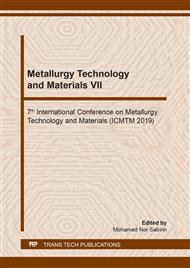[1]
T. Inamura, Y. Yamamoto, H. Hosoda, H. Y. Kim, S. Miyazaki, Crystallographic orientation and stress-amplitude dependence of damping in the martensite phase in textured Ti-Nb-Al shape memory alloy, Acta Mater., 58 (2010) 2535-2544.
DOI: 10.1016/j.actamat.2009.12.040
Google Scholar
[2]
Y. Al-Zain, H. Y. Kim, T. Koyano, H. Hosoda,S. Miyazaki, Anomalous temperature dependence of the superelastic behavior of Ti-Nb-Mo alloys, Acta Mater., 59 (2011) 1464-1473.
DOI: 10.1016/j.actamat.2010.11.008
Google Scholar
[3]
Z.C. Zhou, J. Du , Y. K. Zhang, Y. S. Gu, Y. J. Yan and H. Yang, Influence of phase constitutions on compressive properties of as sintered and as quenched alloys, International Heat Treatment and Surface Engineering, 8(2014)144-148.
DOI: 10.1179/1749514814z.000000000115
Google Scholar
[4]
D. Kuroda, M. Niinomi, M. Morinaga, Y. Kato, T. Yashiro, Design and mechanical properties of new β type titanium alloys for implant materials, Mater. Sci. Eng. A, 243 (1998) 244-249.
DOI: 10.1016/s0921-5093(97)00808-3
Google Scholar
[5]
D. Raabe, B. Sander, M. Friák, D. Ma, J. Neugebauer, Theory-guided bottom-up design of β- titanium alloys as biomaterials based on first principles calculations: theory and experiments, Acta Mater., 55 (2007) 4475-4487.
DOI: 10.1016/j.actamat.2007.04.024
Google Scholar
[6]
A. S. Nowick, B. S. Berry, Anelastic relaxation in crystalline solids, ( Now York and London: Academic Press),(1972).
Google Scholar
[7]
O. Florêncio, W. J. Botta F, C. R. Grandini, H. Tejima, J. A. R. Jordão, Anelastic behavior in Nb-Ti alloys containing interstitial elements, J. Alloys Comp., 211-212(1994) 37-40.
DOI: 10.1016/0925-8388(94)90442-1
Google Scholar
[8]
L. H. Almeida, C. R. Grandini, R. Caram, Anelastic spectroscopy in Ti alloy used as biomaterial, Mater. Sci. Eng. A, 521-522( 2009) 59-62.
DOI: 10.1016/j.msea.2008.09.123
Google Scholar
[9]
M. Weller, G. Y. Li,J. X. Zhang, T. S. Kê, Accurate determination of activation enthalpies associated with the stress-induced migration of oxygen or nitrogen in tantalum and niobium, Acta Metall., 29(1981)1047-1054.
DOI: 10.1016/0001-6160(81)90056-0
Google Scholar
[10]
J. L. Murray, Phase Diagram of Binary Titanium Alloys, Materials Park (Ohio: American Society for Metals)1987 p.188.
Google Scholar
[11]
J. R. S. Martins JR, R. O. Araujo, R. A. Nogueira, C. R. Grandini, Internal friction and microstructure of Ti and Ti-Mo alloys containing oxygen, Arch. Metall. Mater., 61 (2016 )25-30.
DOI: 10.1515/amm-2016-0011
Google Scholar
[12]
J. L. Snoek, Effect of small quantities of carbon and nitrogen on the elastic and plastic properties of iron, Physica, 8(1941)711-733.
DOI: 10.1016/s0031-8914(41)90517-7
Google Scholar
[13]
J. E. Doherty, D. F. Gibbons, Internal friction studies in some Titanium and Zirconium based alloys, Acta Metall., 19(1971) 275-282.
DOI: 10.1016/0001-6160(71)90093-9
Google Scholar
[14]
T. C. Niemeyer, J. M. A. Gimenez, L. H. Almeida, C. R. Grandini, O. Florêncio, Activation energy measurement of oxygen ordering in Nb-Ti alloy by anelastic relaxation, Materials Research, 15(2002) 143-147.
DOI: 10.1590/s1516-14392002000200010
Google Scholar
[15]
F. X. Yin, S. Satoshi, D. H. Ping and K. Nagai, Snoek-type high-damping alloys realized in β-Ti alloys with high oxygen solid solution, Adv. Mater., 18(2006) 1541-1544.
DOI: 10.1002/adma.200600128
Google Scholar
[16]
P. P. Tung and A. W. Sommer, A study of dislocation-hydrogen interaction in α-Titanium via internal friction measurements, Acta Metall., 22 (1974) 191-200.
DOI: 10.1016/0001-6160(74)90010-8
Google Scholar
[17]
F. X. Yin, L. M. Yu, D. H. Ping, S. Iwasaki, Snoek relaxation in bcc Metals and high damping β-Ti alloys, Mater. Sci. Forum, 614 (2009) 175-180.
DOI: 10.4028/www.scientific.net/msf.614.175
Google Scholar
[18]
M. S. Ahmad, Z. C. Szkopiak, Snoek relaxation peaks in solid solutions of niobium, J. Phys. Chem. Solids, 31(1970)1799-1804.
DOI: 10.1016/0022-3697(70)90170-8
Google Scholar
[19]
M. Weller, G. Hanceczok, J. Diehl, Internal-friction studies on oxygen-oxygen interaction in niobium: 1. Experimental results and application of previous interpretations,Phys. Stat. Sol. B,172(1992)145-159.
DOI: 10.1002/pssb.2221720115
Google Scholar
[20]
R. Cantelli,The roots and the future of mechancial spectroscopy,Mater. Sci. Eng. A, 442(2006) 5-20.
Google Scholar
[21]
M.Weller, The Snoek relaxation in bcc metals-from steel wire to meteorites, Mater. Sci. Eng. A, 442(2006) 21-30.
DOI: 10.1016/j.msea.2006.02.232
Google Scholar
[22]
C. R.Grandini , O. Florêncio, W. J. B. Filho, Diffusion of interstitial solutes in Nb-46(wt.%)Ti alloys measured by meachanical spectroscopy,Defect Diffus. Forum, 326-328(2012) 708-712.
DOI: 10.4028/www.scientific.net/ddf.326-328.708
Google Scholar
[23]
Z. C. Zhang, Y. K. Zhang, J. Du, Y. J. Yan, S. Y. Gu, Snoek-type anelastic relaxation in a water-quenched Ti-Nb alloy,Applied Mechanics Materials, 487(2014),3-6.
DOI: 10.4028/www.scientific.net/amm.487.3
Google Scholar
[24]
H. Lu, C. X. Li, F. X. Yin, Q. F. Fang,O.Umezawa, Effects of alloying elements on the Snoek-type relaxation in Ti-Nb-X-O alloys (X=Al, Sn, Cr, and Mn),Mater. Sci. Eng. A 541(2012) 28-32.
DOI: 10.1016/j.msea.2012.01.113
Google Scholar
[25]
H. Lu,C. X. Li, F. X. Yin, Q. F. Fang,O.Umezawa, Effects of alloying elements on the oxygen Snoek-type relaxation in Ti-Nb alloys, Solid State Phenom., 184(2012) 75-78.
DOI: 10.4028/www.scientific.net/ssp.184.75
Google Scholar
[26]
I. S. Golovin and S. B. Golovina, Effect of alloying α-Fe with Aluminum, Silicon,Cobalt,and Germanium on the Snoek relaxation parameters,Physics of Metals and Metallography,102 (2006) 593-603.
DOI: 10.1134/s0031918x06120064
Google Scholar
[27]
Z.C. Zhou, J. Du, X. B. Zhu, Y. J. Yan, X. F. Wang, Snoek-type anelastic relaxation in sintered β-tpye Ti-Nb alloys (in Chinese), submitted to Acta physica sinica.
Google Scholar


